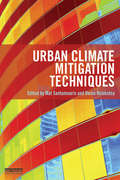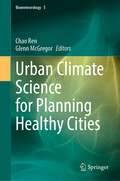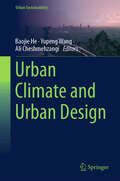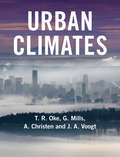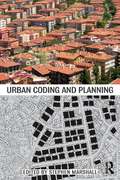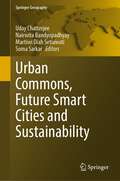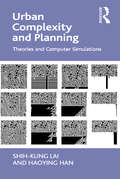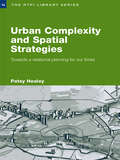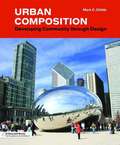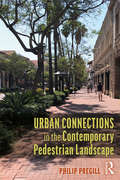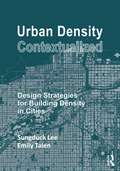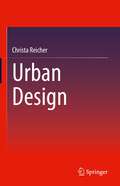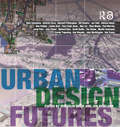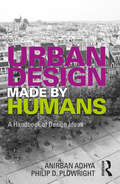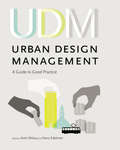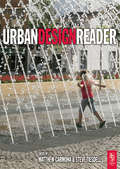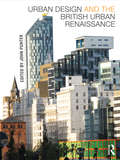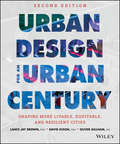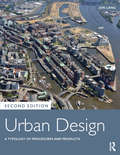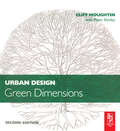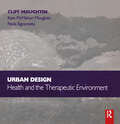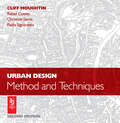- Table View
- List View
Urban Climate Mitigation Techniques
by Mat Santamouris Denia KolokotsaThe urban climate is continuously deteriorating. Urban heat lowers the quality of urban life, increases energy needs, and affects the urban socio-economy. Urban Climate Mitigation Techniques presents steps that can be taken to mitigate this situation through a series of innovative technologies and examples of best practices for the improvement of the urban climate. Including tools for evaluation and a comparative analysis, this book addresses anthropogenic heat, green areas, cool materials and pavements, outdoor shading structures, evaporative cooling and earth cooling. Case studies demonstrate the success and applicability of these measures in various cities throughout the world. Useful for urban designers, architects and planners, Urban Climate Mitigation Techniques is a step by step tour of the innovative technologies improving our urban climate, providing a holistic approach supported by well-established quantitative examples.
Urban Climate Science for Planning Healthy Cities (Biometeorology #5)
by Chao Ren Glenn McGregorThis volume demonstrates how urban climate science can provide valuable information for planning healthy cities. The book illustrates the idea of "Science in Time, Science in Place" by providing worldwide case-based urban climatic planning applications for a variety of regions and countries, utilizing relevant climatic-spatial planning experiences to address local climatic and environmental health issues. Comprised of three major sections entitled "The Rise of Mega-cities and the Concept of Climate Resilience and Healthy Living," "Urban Climate Science in Action," and "Future Challenges and the Way Forward," the book argues for the recognition of climate as a key element of healthy cities. Topics covered include: urban resilience in a climate context, climate responsive planning and urban climate interventions to achieve healthy cities, climate extremes, public health impact, urban climate-related health risk information, urban design and planning, and governance and management of sustainable urban development. The book will appeal to an international audience of practicing planners and designers, public health and built environment professionals, social scientists, researchers in epidemiology, climatology and biometeorology, and international to city scale policy makers.
Urban Climate and Urban Design (Urban Sustainability)
by Yupeng Wang Ali Cheshmehzangi Baojie HeDue to climate change and urbanization, urban climate change is increasingly prominent with significantly environmental, economic, social, and health consequences. Addressing climate-related risks, threats and disasters in cities to a significant extent means creating resilient, healthy, safe and inclusive built environments. Such an assumption is much truer since cities are the main human settlements of human beings. Typically, urban design is an implementable and tangible pathway to practically deal with the city-climate interactions, while there should be a large transformation from unsustainable urban design patterns towards sustainable ones. Urban Climate and Urban Design is a comprehensive collection of theoretical perspectives and global case study examples focused on three core areas of (i) urban climate monitoring, assessing and forecasting, (ii) mitigation and adaptation strategies, (iii) advanced and emerging design models and tools, and (iv) action plans and policy formulation. This edited volume provides theoretical and methodological references for urban climate research and generates practical implications for mitigation and adaptation capacity improvement. This book will be of interest to a range of researchers from earth and planetary sciences and environmental sciences to engineering, architecture, and urban planning. Beyond them, this book will enlighten policy makers, practitioners, and developers how to properly regulate urban climate through design interventions. We believe this book is promising to narrow the gap in the transition towards climate-resilient cities, and enhance the understanding of new ideas, methods, strategies, and policies.
Urban Climates
by Gerald Mills Andreas Christen James A. Voogt Timothy R. OkeUrban Climates is the first full synthesis of modern scientific and applied research on urban climates. The book begins with an outline of what constitutes an urban ecosystem. It develops a comprehensive terminology for the subject using scale and surface classification as key constructs. It explains the physical principles governing the creation of distinct urban climates, such as airflow around buildings, the heat island, precipitation modification and air pollution, and it then illustrates how this knowledge can be applied to moderate the undesirable consequences of urban development and help create more sustainable and resilient cities. With urban climate science now a fully-fledged field, this timely book fulfills the need to bring together the disparate parts of climate research on cities into a coherent framework. It is an ideal resource for students and researchers in fields such as climatology, urban hydrology, air quality, environmental engineering and urban design.
Urban Coding and Planning: Urban Coding And Planning (Planning, History and Environment Series)
by Stephen MarshallUrban codes have a profound influence on urban form, affecting the design and placement of buildings, streets and public spaces. Historically, their use has helped create some of our best-loved urban environments, while recent advances in coding have been a growing focus of attention, particularly in Britain and North America. However, the full potential for the role of codes has yet to be realized. In Urban Coding and Planning, Stephen Marshall and his contributors investigate the nature and scope of coding; its purposes; the kinds of environments it creates; and, perhaps most importantly, its relationship to urban planning. By bringing together historical and ongoing traditions of coding from around the world – with chapters describing examples from the United Kingdom, France, India, China, Japan, Australia, South Africa, the United States and Latin America – this book provides lessons for today’s theory and practice of place-making.
Urban Commons, Future Smart Cities and Sustainability (Springer Geography)
by Uday Chatterjee Nairwita Bandyopadhyay Martiwi Diah Setiawati Soma SarkarThis book provides a critical theoretical framework for understanding the implementation and development of smart cities as innovation drivers, with long-term effects on productivity, livability, and the sustainability of specific initiatives. This framework is based on an empirical analysis of 21 case studies, which include pioneer projects from various regions. It investigates how successful smart city initiatives foster technological innovation by combining regulatory governance and private agency. The typologies of smart city-making approaches are thoroughly examined. This book presents the holistic approach of smart cities, which start from current issue and challenges, advanced technological development, disaster mitigation, ecological perspective, social issue, and urban governance. The book is organized into five major parts, which reflect interconnection between theories and practice. Part one explains the introduction which reflects the diversity and challenges of the urban commons and its regeneration. Part two covers the current and future situation of urban growth, anglomeration agglomeration, and urban infrastructure. This section includes rethinking urban sprawl: moving towards sustainable cities, drivers of urban growth and infrastructure, urban land use dynamics and urban sprawl and urban infrastructure sustainability and resilience. Part three describes climate crisis, urban health, and waste management. This section includes climate change and health impacts in urban areas, green spaces: an invaluable resource for delivering sustainable urban health, health and wellbeing and quality of life in the changing urban environment, urban climate and pollution—case study, sustainable urban waste management and urban sustainability and global warming and urban heat Island. Part four covers the ecological perspectives, advanced technology, and social impact for i.e., smart building, ecosystem services, society and future smart cities (SSC). This section includes urban ecosystem services, environmental planning, and city management, artificial intelligence and urban hazards and societal impact, and using geospatial application and urban/smart city energy conservation—case study. Part five covers urban governance, smart solutions, and sustainable cities. It includes good governance, especially e-governance and citizen participation, urban governance, space and policy planning to achieve sustainability, smart city planning and management and Internet of things (IoT), advances in smart roads for future smart cities, sustainable city planning, innovation, and management, future strategy for sustainable smart cities and lessons from the pandemic: the future of smart cities.
Urban Complexity and Planning: Theories and Computer Simulations
by Shih-Kung Lai Haoying HanIn recent years, there has been a new understanding of how cities evolve and function, which reflects the emergent paradigm of complexity. The crux of this view is that cities are created by differentiated actors involved in individual, small-scale projects interacting in a complex way in the urban development process. This 'bottom up' approach to urban modeling not only transforms our understanding of cities, but also improves our capabilities of harnessing the urban development process. For example, we used to think that plans control urban development in an aggregate, holistic way, but what actually happens is that plans only affect differentiated actors in seeking their goals through information. In other words, plans and regulations set restrictions or incentives of individual behaviour in the urban development process through imposing rights, information, and prices, and the analysis of the effects of plans and regulations must take into account the complex urban dynamics at a disaggregate level of the urban development process. Computer simulations provide a rigorous, promising analytic tool that serves as a supplement to the traditional, mathematical approach to depicting complex urban dynamics. Based on the emergent paradigm of complexity, the book provides an innovative set of arguments about how we can gain a better understanding of how cities emerge and function through computer simulations, and how plans affect the evolution of complex urban systems in a way distinct from what we used to think they should. Empirical case studies focus on the development of a compact urban hierarchy in Taiwan, China, and the USA, but derive more generalizable principles and relationships among cities, complexity, and planning.
Urban Complexity and Spatial Strategies: Towards a Relational Planning for Our Times (RTPI Library #14)
by Patsy HealeyUrban Complexity and Spatial Strategies develops important new relational and institutionalist approaches to policy analysis and planning, of relevance to all those with an interest in cities and urban areas. Well-illustrated chapters weave together conceptual development, experience and implications for future practice and address the challenge of urban and metropolitan planning and development. Useful for students, social scientists and policy makers, Urban Complexity and Spatial Strategies offers concepts and detailed cases of interest to those involved in policy development and management, as well as providing a foundation of ideas and experiences, an account of the place-focused practices of governance and an approach to the analysis of governance dynamics. For those in the planning field itself, this book re-interprets the role of planning frameworks in linking spatial patterns to social dynamics with twenty-first century relevance.
Urban Composition
by Mark C. ChildsCities and towns are among humanity's greatest achievements, yet no single individual or organization creates them. The buildings, streets, and gardens of even a small town embody substantial investments of money, natural resources, and political capital. Much more than the sum of its parts, a settlement's vitality comes from its collective composition. Sometimes the cities and towns that emerge are glorious places, but too frequently they have only fragments of greatness or are soulless and environmentally unhealthy. Our new Architecture Brief Urban Composition shows architects, planners, artists, and engineers of individual projects how they can best fulfill their public trust to help make meaningful urban places. Each chapter contains a set of design queries followed by a discussion, illustrations, and references for further research. This accessible primer on urban design provides guidelines for designing buildings or plans for large cities or small towns. Urban Composition showcases projects across the United States and internationally, in metropolitan areas such as Chicago, Seattle, and London, and small communities such as Marfa, Texas.
Urban Connections in the Contemporary Pedestrian Landscape
by Philip PregillUrban Connections in the Contemporary Pedestrian Landscape explores the significant physical and cultural changes in our urban areas following the implementation of design strategies and increased pedestrian activity. Beginning with a history of the urban grid, the book then discusses experiential factors of pedestrianized urban landscapes in three scales, arterials, collectors and locals, with an emphasis on inductive and deductive design alternatives. It closely examines elements derived from current urban pedestrian experiences including form, scale, surfaces and identity and provides alternative design solutions for the future. Uniquely focusing on a hierarchical discussion of the quality of contemporary landscape design applications within the urban grid, and with illustrated examples throughout the text, this will be useful recommended reading for academics, researchers and postgraduate students on urban landscape and design courses.
Urban Crime Control in Cinema: Fallen Guardians and the Ideology of Repression (Palgrave Studies in Crime, Media and Culture)
by Vladimir RizovThis book uses popular films to understand the convergence of crime control and the ideology of repression in contemporary capitalism. It focuses on the cinematic figure of the fallen guardian, a protagonist who, in the course of a narrative, falls from grace and becomes an enemy of the established social order. The fallen guardian is a figure that allows for the analysis of a particular crime control measure through the perspective of both an enforcer and a target. The very notion of ‘justice’ is challenged, and questions are posed in relation to the role that films assume in the reproduction of policing as it is. In doing so, the book combines a historical far-reaching perspective with popular culture analysis. At the core remains the value of the cinematic figure of the fallen guardian for contemporary understandings of urban space and urban crime control and how films are clear examples of the ways in which the ideology of repression is reproduced.This book questions the justifications that are often given for social control in cities and understands cinema as a medium for offering critique of such processes and justifications. Explored are the crime control measures of private policing in relation to RoboCop (1987), preventative policing and Minority Report (2002), mass incarceration in The Dark Knight Rises (2012), and extra-judicial killing in Blade Runner 2049 (2017). The book speaks to those interested in crime control in critical criminology, cultural criminology, urban studies, and beyond.
Urban Density Contextualized: Design Strategies for Building Density in Cities
by Emily Talen Sungduck LeeUrban Density Contextualized provides planners with the tools to understand, assess, and implement urban density successfully.It systematically explores the social context of urban density, and how it plays a role in urban design and planning strategies. Cities and places have unique cultures and identities, and a wide range of considerations need to be considered in the attempt to insert more density. This book acknowledges this relationship—between urban density and social and physical context—and investigates the ways in which density can use this context to enhance livability and promote a more sustainable world. Chapters include the following topics: density and housing, accessibility, affordability, zoning, typology, and history, as well as case studies of design strategy from across the U.S.It is essential for urban planners, architects, landscape architects, and others working in design and planning fields.
Urban Design
by Christa ReicherIn this basic textbook, prospective architects, urban and landscape planners receive assistance in working on urban development projects and designs. This edition has been expanded by two chapters on informal urban planning and regional urban development. The contents presented and their preparation are based on the design process in practice and embed it in a theoretical framework of necessary background knowledge. As an introduction, an overview of the understanding of the city, of urban structures and the laws governing them is given. In order to make the multi-layered structure of the city more comprehensible, it is broken down into different layers and building blocks. The approach to urban design is described using the "layer method" in the form of successive phases. Examples of urban development projects and competitions illustrate the individual design steps.
Urban Design Futures
by Malcolm Moor Jon RowlandThe last decade has seen the rise of urban design which has taken a central position in the new agendas for urban regeneration and renaissance. Urban design has moved from marginality to mainstream. The principles espoused by urban designers over the past thirty years are now accepted as key to a better urban environment and as we move towards greater sustainability, different ideas are emerging that are challenging some of the accepted urban design norms; urban design is at a watershed. Urban Design Futures presents essays from an international cast of authors to review progress and explore emerging ideas: should urban design reflect the future rather than recreate the past? What are the new driving forces that will shape urban living and hence urban design in the future? This book explores new concepts and points the way towards a series of urban design paradigms for the twenty-first century.
Urban Design Made by Humans: A Handbook of Design Ideas
by Anirban Adhya Philip D. PlowrightThe design of urban environments is complex and involves diverse needs, organisations, professions, authorities, and communities. It requires relationships to be constructed and sustained between infrastructure, resources, and populations across multiple scales. This can be quite daunting. However, at the core of urban design is a simple idea—our urban spaces are designed to allow people and communities to thrive. For that reason, a good starting point for urban designers is to focus on the way people think when engaging our built environment. This thinking is embodied, developed through the interactions between our mind, body, and the environment around us. These embodied concepts are central to how we see the world, how we move and gather, and how we interact with others. They are also the same ideas we use to design our environments and cities. Urban Design Made by Humans is a reference book that presents 56 concepts, notions, ideas, and agreements fundamental to the design and interpretation of our human settlements. The ideas here parallel those found in Making Architecture Through Being Human but extends them into urban environments. Urban Design Made by Humans distinctly highlights priorities in urban design in how we produce meaningful environments catering to wider groups of people. Each idea is isolated for clarity with short and concise definitions, examples, and illustrations. They are organised in five sections of increasing complexity. Taken as a whole, the entries frame the priorities and values of urban design while also being instances of a larger system of human thinking.
Urban Design Management: A Guide to Good Practice
by Antti Ahlava Harry EdelmanThis is an introduction to the secrets of Urban Design Management (UDM). The book examines the roles of the players involved in land-use projects and describes good collaborative methods of practice in project-based urban design and planning, putting emphasis on the creative co-operative skills and the wide knowledge of the participants in a working group. The role of the architect is examined in relation to design, planning and project management with particular emphasis on collaboration and negotiation skills. Specific issues considered include: The make-up of a good project team Ways to make the project team function together Objectives and benefits of project-orientated planning The need to take local characteristics into account in project-orientated planning The preparation required for a co-operative planning process and how initial information can be collected and used How to define project content, and outlining the project itself Partner-specific strategies Urban Design Management contains international examples and many diagrams and photographs, making it a useful and accessible guide for all built environment professionals working in the public realm and those studying architecture, urban design and planning at a graduate level.
Urban Design Reader
by Steve Tiesdell Matthew CarmonaEssential reading for students and practitioners of urban design, this collection of essays introduces the 6 dimensions of urban design through a range of the most important classic and contemporary key texts. Urban design as a form of place making has become an increasingly significant area of academic endeavour, of public policy and professional practice. Compiled by the authors of the best selling Public Places Urban Spaces, this indispensable guide includes all the crucial definitions and various understandings of the subject, as well as a practical look at how to implement urban design that readers will need to refer to time and time again. Uniquely, the selections of essays that include the works of Gehl, Jacobs, and Cullen, are presented substantially in their original form, and the truly accessible dip-in-and-out format will enable readers to form a deeper, practical understanding of urban design.
Urban Design and People
by Michael DobbinsThis introduction to the field of urban design offers a comprehensive survey of the processes necessary to implement urban design work, explaining the vocabulary, the rules, the tools, the structures, and the resources in clear and accessible style. Providing a comprehensive framework for understanding urban design principles and strategies, the author argues that urban design is both a process and a collaboration in which the different forces involved are knit together. Moving from the regional scale down to the scale of places, the book examines the goals and strategies of the urban designer from the viewpoints of the private sector, public sector, and community. The text is illustrated throughout with photographs and drawings that make theory and practice relevant and alive.
Urban Design and the British Urban Renaissance
by John PunterAre Britain’s cities attractive places in which to live, work and play? Asking that question, this is a critical review of how the design dimension of the Urban Renaissance strategy was developed and applied, based on expert academic assessments of progress in Britain’s thirteen largest cities. The case studies are preceded by a dissection of New Labour’s renaissance agenda, and concluded by a synthesis of achievements and failings. Exploring the implications of this strategy for the future of urban planning and design, this is a must-read for students, practitioners of these subjects and for all those who wish to improve the quality of the British urban environment.
Urban Design for an Urban Century: Shaping More Livable, Equitable, and Resilient Cities
by Lance Jay Brown David DixonThis book offers a comprehensive introduction to urban design, from a historical overview and basic principles to practical design concepts and strategies. It discusses the demographic, environmental, economic, and social issues that influence the decision-making and implementation processes of urban design. The Second Edition has been fully revised to include thorough coverage of sustainability issues and to integrate new case studies into the core concepts discussed.
Urban Design: A Typology of Procedures and Products
by Jon LangUrban Design: A Typology of Procedures and Products, 2nd Edition provides a comprehensive and accessible introduction to urban design, defining the field and addressing the controversies and goals of urban design. Including over 50 updated international case studies, this new edition presents a three-dimensional model with which to categorize the processes and products involved: product type, paradigm type, and procedural type. The case studies not only illuminate the typology but provide information that designers can use as precedents in their own work. Uniquely, these case study projects are framed by the design paradigm employed, categorized by procedural type instead of instrumental or land use function. The categories used here are Total Urban Design, All-of-a-piece Urban Design, Plug-in Urban Design, and Piece-by-piece Urban Design. Written for both professionals and those encountering urban design in their day-to-day life, Urban Design is an essential introduction to the field and practice, considering the future direction of the field and what can be learned from the past.
Urban Design: A Typology of Procedures and Products
by Jon LangUrban Design: A Typology of Procedures and Products, 2nd Edition provides a comprehensive and accessible introduction to urban design, defining the field and addressing the controversies and goals of urban design. Including over 50 updated international case studies, this new edition presents a three-dimensional model with which to categorize the processes and products involved: product type, paradigm type, and procedural type. The case studies not only illuminate the typology but provide information that designers can use as precedents in their own work. Uniquely, these case study projects are framed by the design paradigm employed, categorized by procedural type instead of instrumental or land use function. The categories used here are Total Urban Design, All-of-a-piece Urban Design, Plug-in Urban Design, and Piece-by-piece Urban Design.Written for both professionals and those encountering urban design in their day-to-day life, Urban Design is an essential introduction to the field and practice, considering the future direction of the field and what can be learned from the past.
Urban Design: Green Dimensions (Urban Design)
by Peter Shirley Cliff MoughtinIn Green Dimensions, Cliff Moughtin relates sustainable development and green design to the realm of urban design and development. Examining regional and local frameworks for design and planning, this book shows how sustainable urban design can be implemented on every scale.Working from a strong theoretical base, the author uses case studies and discusses policy developments, in order to challenge the conventional wisdom onsustainable design. The book provides a rounded discussion of the application and suitability of current practice, and predicts future design needs.Updating the reader on topics such as energy efficiency, sustainable city forms and the culture of new urbanism, this completely revised and restructured second edition also includes brand new chapters on the Urban Park and Bio-diversity.
Urban Design: Health and the Therapeutic Environment
by Paola Signoretta Kate McMahon Moughtin J.C. Moughtin'Urban Design: Health and the Therapeutic Environment' demonstrates how urban design and planning impact on public health and sustainable development. Moughtin et al. explore the concept of what makes a physically and psychologically ‘healthy’ environment in the context of the paramount need for new homes where living standards are not compromised, in increasingly crowded cities. • Sets out the history and development of the healthy city, from the English spa town to standards of care in Cuba to provide a context for modern urban health development. • Covers a wide range of environmental, ecological, health and epidemiological issues. • Case studies and examples show how health policy and procedure is practically applied to sustainable urban development. 'Urban Design: Health and the Therapeutic Environment' outlines best practice for healthy, sustainable urban design and provides a reference tool for architects, urban designers, landscape architects, health professionals and planners. Emeritus Professor Cliff Moughtin was Professor of Planning in The Queen’s University Belfast and The University of Nottingham. He is author of a number of books including the series of five Urban Design titles for Architectural Press. Kate McMahon Moughtin is a psychotherapist. She is author of Focused Therapy for Organisations and Individuals. She is interested in how literature and environmental infl uences contribute to wellbeing. Paola Signoretta is a human geographer. She is a senior research associate in the Centre for Research in Social Policy, Loughborough University. She is interested in the geographies of health, deprivation and social and financial exclusion.
Urban Design: Method And Techniques
by Paola Signoretta Rafael Cuesta Christine Sarris J.C MoughtinThis book deals with a wide range of techniques used in the urban design process. It then goes on to relate these techniques to a unique, comprehensive account of method. A method of urban design is developed which has sustainability and environmental protection at the centre of its philosophy. Previously, literature regarding the urban design method has been almost totally neglected; this book introduces the topic to the reader. This revised Second Edition encompasses the latest techniques including the development of geographic information systems and financial techniques which help evaluate projects.A number of techniques are illustrated by example or case study. Where techniques are discussed they are located within the structure of the design process. The book develops a logical framework for a process, which includes problem definition, survey, analysis, concept generation, evaluation and implementation. It is this framework which leads toward the development of an urban design method. This book is a practical guide for students or professionals in the early part of their careers. It is organized so that each chapter provides guidance which readers would have otherwise had to discover for themselves, often with some difficulty.
